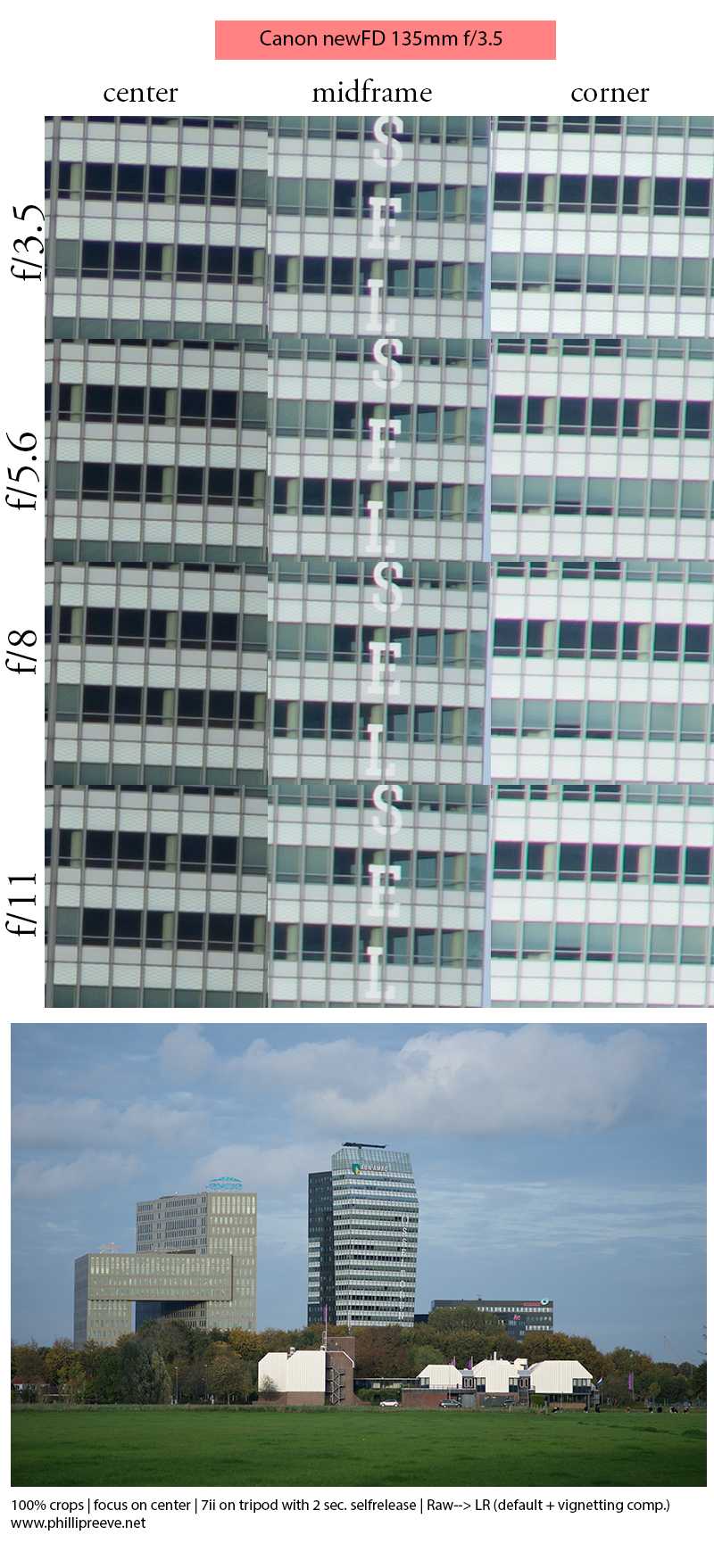Distortion
There is only an absolutely negligible amount of pincushion distortion with no field relevance.
Bokeh
Sony A7rII |Canon EF 135mm 2.0 L | f/2.0 | shot through a window | full resolution
The very smooth bokeh is one of the main selling points of this lens. There is also hardly any distracting outlining and no onion-ring like structure in the light discs. Only the cat’s eye effect – describing light discs becoming ovals towards the borders and corners – is quite pronounced.
Sony A7rII |Canon EF 135mm 2.0 L | f/2.0 | full resolutionSony A7rII |Canon EF 135mm 2.0 L | f/2.0 | full resolution
Sunstars
Between f/2.0 and f/4.0 the sunstars are not so great, between f/5.6 and f/16 they are quite decent. Compared to the 70-200mm 4.0L the performance is a little bit better here. But this is more of a personal bias, so you may come to a different conclusion when looking at the samples.
Chromatic aberrations
longitudinal
Sony A7rII |Canon EF 135mm 2.0 L | f/2.0 | 25% crop, minimum focus distance
Longitudinal CA (loCA) are definetly present and I would even consider them a weakness of the lens. Nevertheless I would describe the performance here as average, there are many fast lenses which perform much worse.
Sony A7rII |Canon EF 135mm 2.0 L | f/2.5 | 100% crop, minimum focus distance
lateral
Sony A7rII | Canon EF 135mm 2.0 L | f/8.0 | CA 100% crop before/after extreme corner
The lateral CA correction is almost perfect. You can spot a tiny hint of CA at one of the edges, but this is absolutely negligible in real world use.
Alternatives
Samyang 135mm 2.0 ED UMC:Check out Jannik’s review. Better loCA correction, otherwise they look pretty similar to me. Also cheaper, even more so when taking the necessary adapter for the Canon into consideration.
Zeiss APO Sonnar T* 135mm 2.0
Rumored to be one of the lenses with the highest resolving power you can buy today. Better loCA correction, bigger, heavier, way more expensive.
Sony/Zeiss Sonnar T* 135mm 1.8 SAL ZA
Check out Phillip’s review as I haven’t used this lens yet. A tad faster, bigger, heavier and more expensive.
Conclusion
good
|
average
|
not good
|
Even on today’s cameras the Canon EF 135mm 2.0L is still an excellent performer. Not only does it offer astonishing sharpness at all distances, it also manages to combine this with a wonderful bokeh and it has therfore already become one of my most favourite portrait lenses and easily so.
From a technical point of view the work against bright light is nothing to write home about. From my personal standpoint I sometimes like having a little flare in my portrait shots so this doesn’t bother me too much, but your mileage may vary here. The loCA correction could also be a little better, but as I am used to shoot portraits with the Nikon AF-S 85mm 1.4G things doesn’t look so bad here in comparison.
I also got word this lens does not work very well with the cheaper adapters, but I have only used it with the Sigma MC-11 personally and was mostly happy with it’s performance.
So, who is this lens for? Anyone, who looks for a very good, fast portrait tele with excellent sharpness and very smooth bokeh. A few years ago this lens was pretty much without competition. Today it might be worth taking a closer look at the Samyang 135mm 2.0, which also offers great performance at a cheaper price point, if you can live with it’s lack of autofocus.
Sample Images
Sony A7rII |Canon EF 135mm 2.0 L | f/2.0Sony A7rII |Canon EF 135mm 2.0 L | f/2.0 | full resolutionSony A7rII |Canon EF 135mm 2.0 L | f/2.0 | full resolutionSony A7rII |Canon EF 135mm 2.0 L | f/2.0 | full resolutionSony A7rII |Canon EF 135mm 2.0 L | f/7.1 | full resolution
Support Us
Did you find this article useful or just liked reading it? Treat us to a coffee!via Paypal
The following two tabs change content below.
My name is Bastian and I am your expert here when it comes to ultra wide angle lenses, super fast portrait lenses (ranging from a 50mm f/0.95 to a 200mm f/1.8) and I also have reviewed way too many 35mm lenses.
Don’t ask me anything about macro or wildlife shooting though.
Latest posts by BastianK
- Review: Canon EF 50mm 1.2 L USM — August 13, 2023
- Review: Cobalt Elite Kodak Portra Film Emulations — August 10, 2023
- Review: Viltrox 75mm 1.2 AF E Pro APS-C — July 31, 2023
Bokeh
The bokeh department is where this lens stands out to me. Unlike what I have observed with many similar 135 mm lenses from the same era, bokeh is very smooth with barely any bokeh fringing. Even very difficult backgrounds are rendered smoothly without outlining. In the corners mild cat’s eyes can be observed but not in the extend it becomes obtrusive.
For full body portraits with objects in the background close to the subject a maximal aperture of f/3.5 is a bit lacking. Nevertheless, the background is calm, and I often found subject isolation to be sufficient.
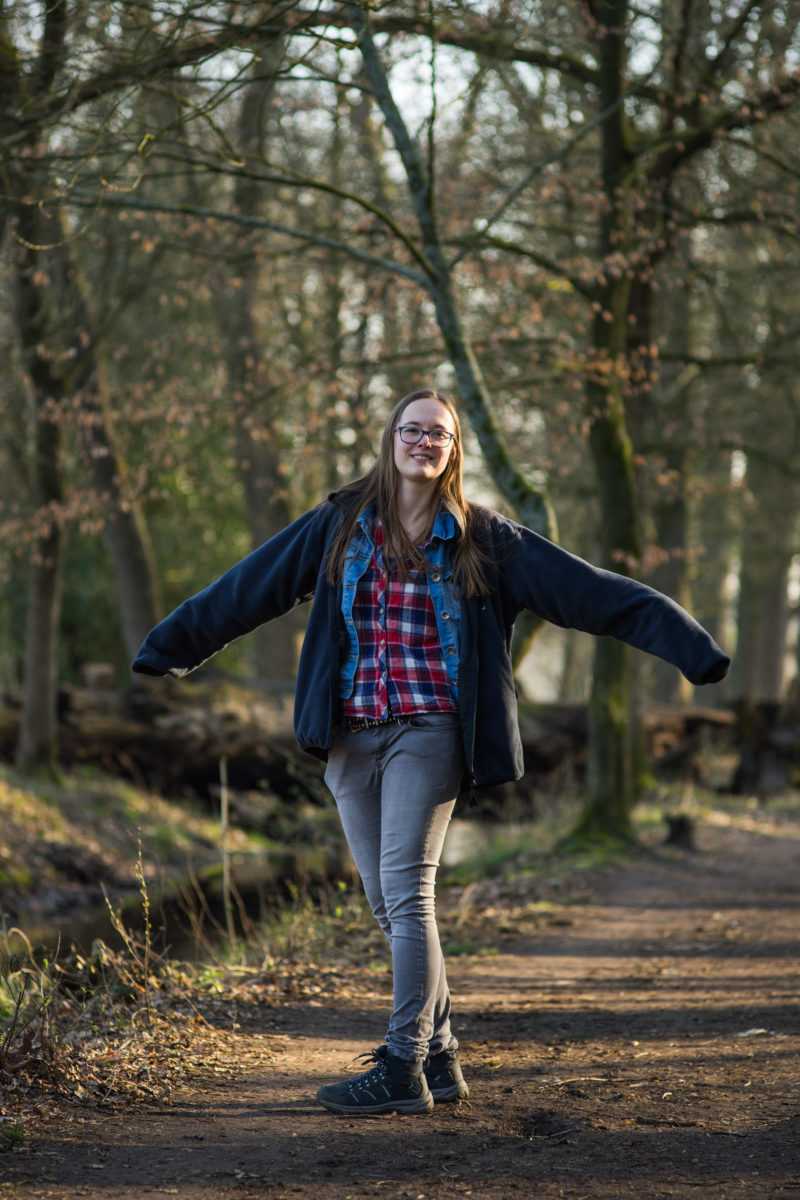 Sony a7II | Canon nFD 3.5/135 | f/3.5
Sony a7II | Canon nFD 3.5/135 | f/3.5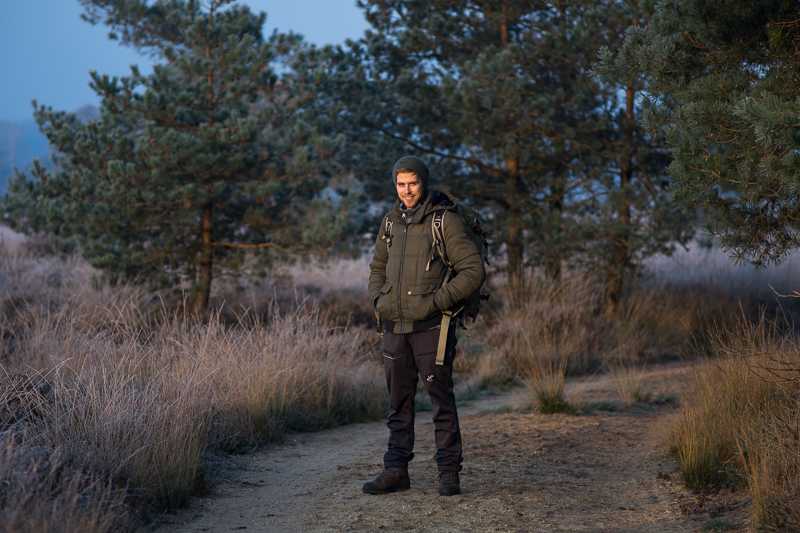 Sony a7II | Canon nFD 3.5/135 | f/3.5
Sony a7II | Canon nFD 3.5/135 | f/3.5
With objects in the background a bit further away I really like the rendering of this lens. Because of the slow aperture there isn’t too much blur, which gives the viewer more context. Because the quality of the bokeh is very good the background does not get distracting.
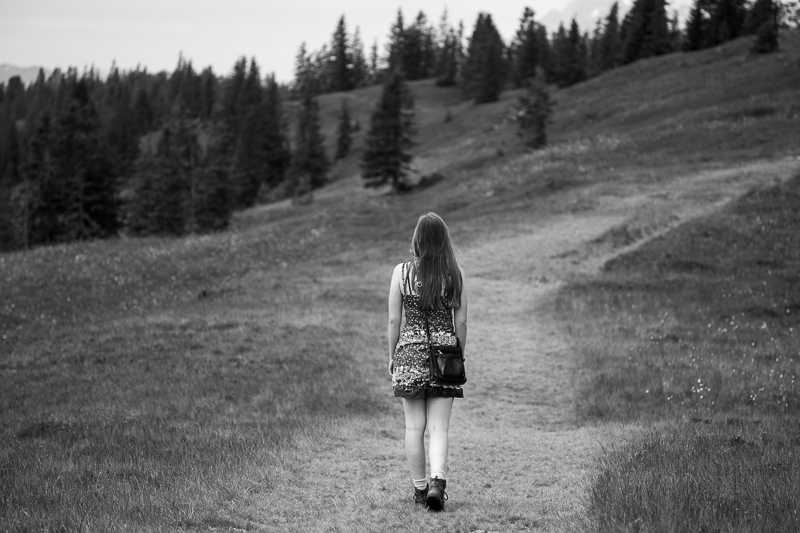 Sony a7II | Canon nFD 3.5/135 | f/3.5
Sony a7II | Canon nFD 3.5/135 | f/3.5
For half body portraits and head shots f/3.5 was always sufficient for me. At these distances bokeh is great too, even with very demanding backgrounds like in the picture below.
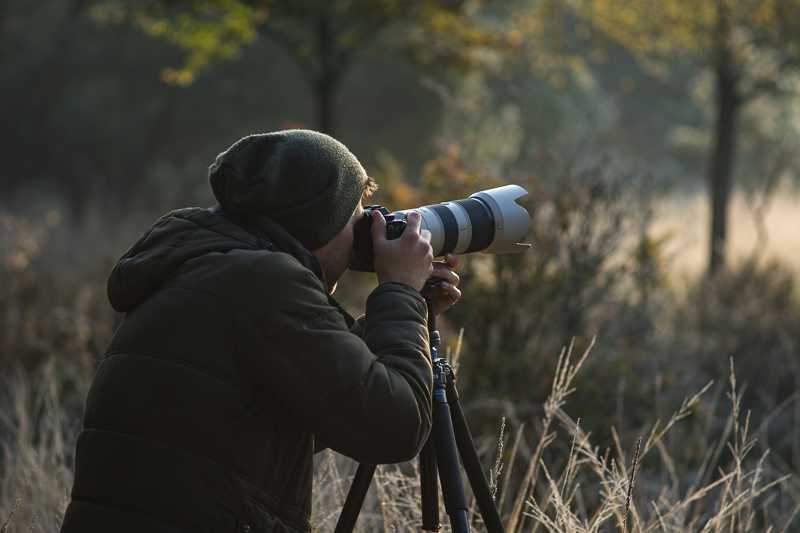 Sony a7II | Canon nFD 3.5/135 | f/3.5
Sony a7II | Canon nFD 3.5/135 | f/3.5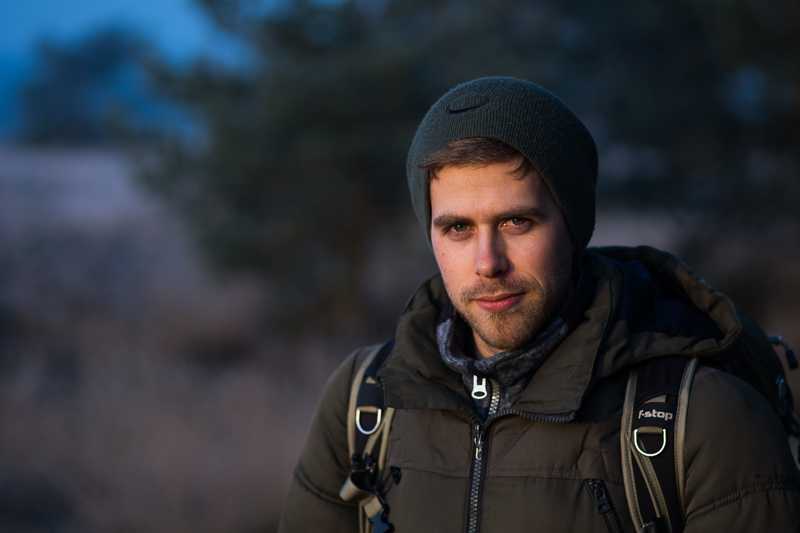 Sony a7II | Canon nFD 3.5/135 | f/3.5
Sony a7II | Canon nFD 3.5/135 | f/3.5
Near MFD bokeh is very smooth, even with difficult backgrounds.
 Sony a7II | Canon nFD 3.5/135 | f/3.5
Sony a7II | Canon nFD 3.5/135 | f/3.5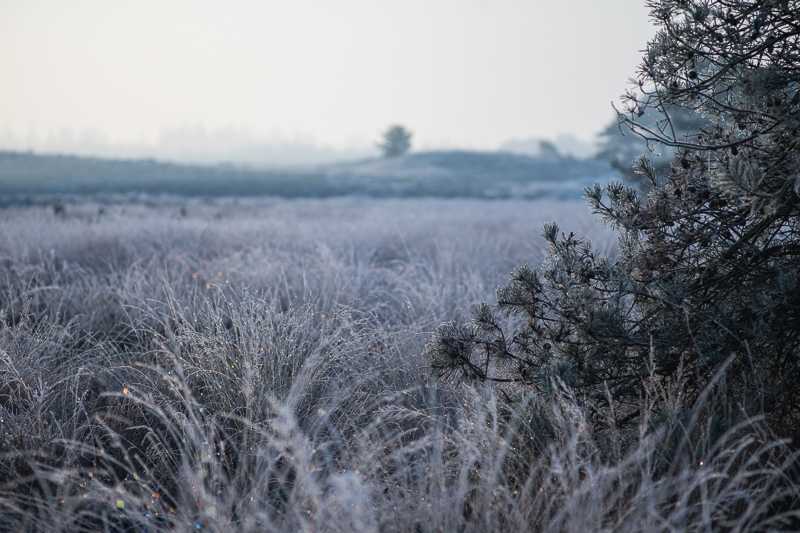 Sony a7II | Canon nFD 3.5/135 | f/3.5
Sony a7II | Canon nFD 3.5/135 | f/3.5
Качество изображения
Во время съемок с этим объективом на презентации редакция
работала с опытной моделью. Поэтому нужно иметь ввиду, что производительность
этого экземпляра не обязательно на 100% соответствует качеству изображения
серийной модели. Тем не менее, 135-миллиметровые объективы оказались одними из
самых резких, и этот объектив не стал исключением, судя по тестовым изображениям.
Нам придется подождать, чтобы получить серийный объектив и сделать
окончательные выводы, но если вы знаете, насколько резкими являются Sigma и
Sony 135 мм F1.8, ожидайте, что производительность Canon 135 мм будет очень схожей.
Canon EF 35-135 mm f/4-5.6 USM
Рекомендуемые
В нашей базе 2007 объективов и 3431 отзыв владельцев.
Вы также можете сравнить объективы рядом
Сравнить объективы
Поиск по:
Производитель:
All7ArtisansAstrHoriCanonCarl ZeissCCCPCosinaFalconFujifilmHasselbladIBE OpticsIrixKenkoKonica MinoltaKowaLeicaMamiyaMeikeMitakonNikon NikkorOlympusOM SystemPanasonicPentaxSainSonicSamsungSamyangSchneider-KreuznachSigmaSiruiSLR MagicSonyTamronTokinaTTartisanerVnugoVenus Optics ViongARVilavash
Модель:
Все
Стиль объектива:
ВсеШирокий уголОбычныйТелефотоУниверсальный зумШирокоугольный зумТелефото зумРыбий глаз
Устанавливать:
AllAdaptall IICanon EFCanon EF-MCanon EF-SCanon RContax & YashicaFour ThirdsFujifilm GFFujifilm XL-mount / Leica-SLLeica M / VM-MountLeica-RLeica-SLeica-TM39M42Micro Four ThirdsNikon 1Nikon FNikon ZPentax KPentax QSamsung Mini NXSamsung NXEo9SigmaSony A / MinoltaSony A / MinoltaES00ES
Canon EF 35–135 мм f/4–5,6 USM
| Производитель | Кэнон |
|---|---|
| Модель | EF 35–135 мм f/4–5,6 USM |
| Стиль линз | Универсальный зум |
| Фокусное расстояние | 35–135 мм |
| Максимальное отверстие | ф/4 — 5,6 |
| Угол обзора | 63,4 — 18,2 или |
| Минимальное расстояние фокусировки | 0,75 м |
| Максимальное увеличение | 1:6,67 |
| Минимальная апертура | 32 |
| Количество лепестков диафрагмы | 5 |
| Тип автофокуса | АФ УСМ |
| Конструкция линзы | 14 элементов / 12 групп |
| Диаметр фильтра | 58 мм |
| Макро | № |
| Доступные крепления | Канон ЭФ |
| Размеры | 72 х 86,4 мм |
| Вес | 425 г |
| Дополнительная информация | Поступил в продажу в марте 1990 г. |
Средняя оценка (6 отзывов владельцев)
Качество сборки
Оптическое качество
Цена денег
Комбинезон
3,89
Средний
Sharpness
In the chart above focus shift is not taken into account, refocusing for the center improves center sharpness a tiny bit and significantly improves corner sharpness. See below: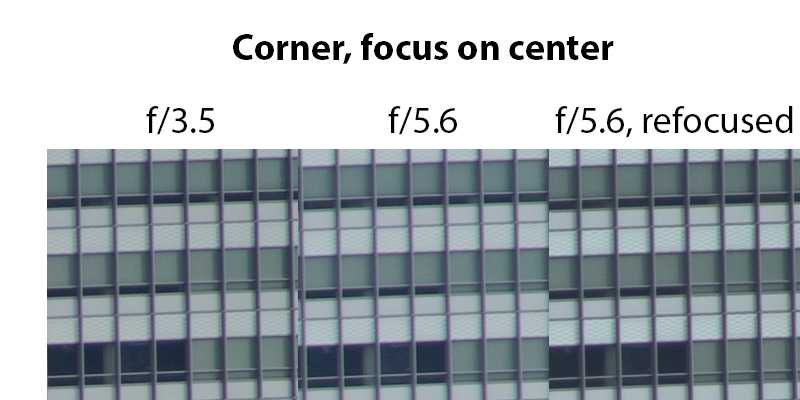
f/3.5: Wide open the center already looks very good, as does the midframe. The corners look very good too.
f/5.6: Across the frame sharpness is very good to excellent now.
f/8: Across the frame sharpness is very good.
f/11: The whole image is softer due to diffraction.
The Canon newFD 3.5/135 is a very sharp lens. I would not hesitate to use this lens wide open, however I often stop down to f/5.6 to reduce aberrations and improve contrast a bit. (micro-)contrast is not very high in comparison with the best modern lenses, but this can be fixed in post quite easily.
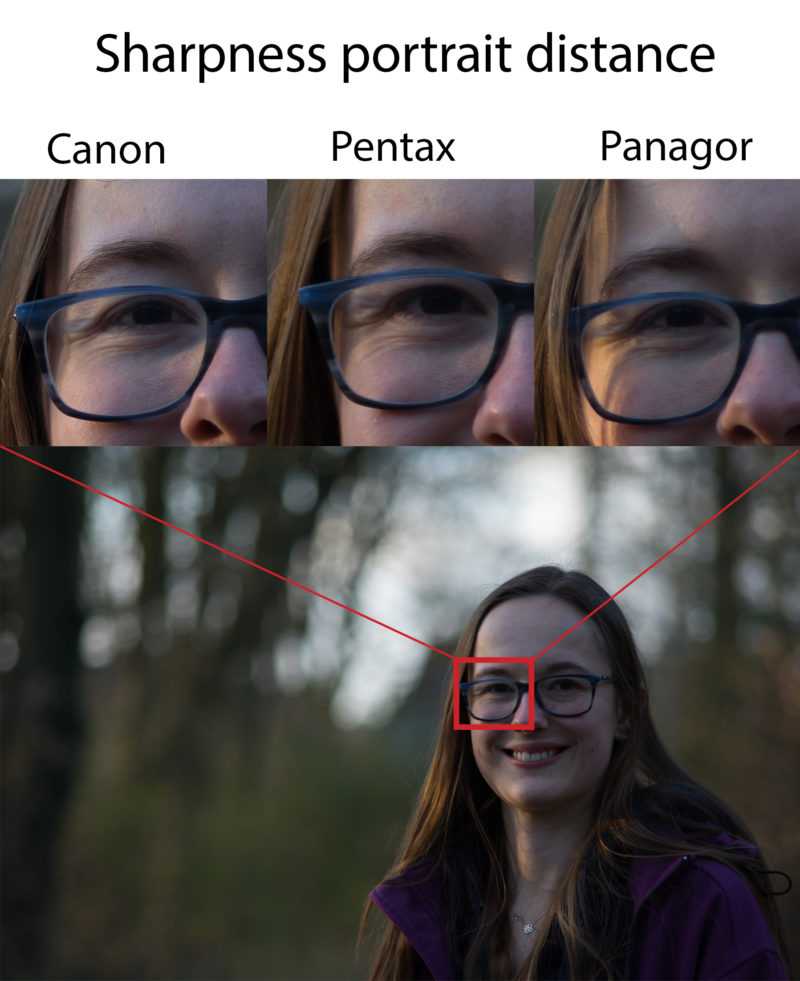
Also near mfd and at typical portrait distances the Canon newFD 3.5/135 is very sharp across the frame from wide open. Lenses like the Pentax-M 3.5/135 are significantly less sharp at similar distances.
Canon FD 35-105mm f3.5
The Canon FD 35-105mm f3.5 is a lens that I expected much from. It has been highly praised among video shooters due to the fact, that the aperture doesn’t change throughout the focal range. That characteristic is not very interesting with respect to this article, but how it behaves with respect to image quality does. Another case is if I find that the X1D II is usable for video recording as well, but that is the theme for a future article. On the X1D this lens corresponds to a 28-84mm f2.8 lens, quite a nice focal range.
The resulting images at 35mm f3.5 shows heavy and hard vignetting and it doesn’t get much better at f11. Sharpness, color rendition and contrast though is quite nice at f3.5 and excellent at f11.
Going to 105mm changes things a little, but not enough to make it usable for imaging. The vignette at f3.5 is quite pronounced and even persists in the outermost corners at f11.
Disappointing results but I can’t wait to do the video review, and why is that? The fact is, when using video by going to 16:9 form factor instead of 4:3 you might crop out exactly the ugly vignette. That could leave this lens like a little gem for video shooting especially considering that you have the aperture of 3.5 throughout the focal range.
You can find the next article in the series here Adapted lenses test #2
Just to sum it all up, here are some facts of the tested Canon lenses.
| Lens | Aperture | Vignetting | Sharpness | Contrast | Chromatic aberration |
| Canon 28mm | 2.8 | Slight, soft | Good center, corners OK | Fine | Little to non |
| Canon 50mm | 1.4 | Hard non removable | OK center, corners soft | Little | Little to non |
| Canon 135mm | 2.5 | Soft and removable | Fine in center, corners OK | OK | Pronounced at f2.5, little at f11 |
| Canon 35-70mm | 3.5-4.5 | 35mm: Soft, almost none af f11. 70mm: visible at f11 | 35mm: Low at f3.5, fine at f11. 70mm: Good at f4.5, low at f11 | OK | Very little |
| Canon 35-105mm | 3.5 | Hard and non removable | Fine in center, corners OK | Fine | Little |
Build quality and handling
Canon newFD 135mm f/3.5
Compared to cheaper modern lenses made mostly from lower grade plastics build quality is very good, but compared to the very best manual lenses build quality is less nice. Nevertheless the lens feels much more solid than the newFD 50 mm f/1.8. The focus ring is made of metal with a plastic grip, the aperture ring is made from high quality plastics. The lens barrel is also made from metal. All markings are engraved and filled with paint. The black finish seems to be scratch resistant, my sample looks like new despite being over 40-years-old.
The focus ring has a pleasant resistance and turns ~220° from MFD to infinity. The aperture nicely clicks with a 1/3 stop click stop between f/3.5 and f/4 and 1/2 stop click stops between f/4 and half stops between f/4-f/32.
The built in hood sits very tight and is covered with felt at the inside. The lens feels well balanced on my a7II but maybe a tad to long, especially when fully extended.
SMC Pentax-M 135mm f3.5
Build quality is very high, the lens is made from nothing but metal apart from the rubber on the focus ring. Tolerances are very tight. The black finish seems to be very scratch resistant, my sample still looks like new. Also my sample is completely free of internal dust, something I have never seen before in such old lenses. All markings are engraved and filled with paint The focus ring has a very pleasant resistance and travels ~215° from MFD to infinity. The aperture nicely clicks with 1/3 of a stop click stops between f/3.5 and f/4 and 1/2 stop click stops between f/4 and f/22 and with another click at f/32. Distance between the clicks is small, so it is not easy to set the aperture between two clicks.
The lens also features a build in hood made of metal. When extended the hood sits tight enough, but is a bit wobbly.
Due to its small size the Pentax feels very well balanced on my a7II, its form factor is a big plus to me.
Panagor PMC auto tele 135mm f/2.8
The build quality of the Panagor seems to be quite good, the lens is made from metal and glas only and feels quite nice. All markings are engraved and filled with paint. My lens still looks very good and is, apart form a few dust spots inside, like new. The Panagor is quite heavy and feels very dense. The focus ring travels from MFD to infinity in roughly 245° and feels oké but resistance is a bit on the high side. Furthermore the focus ring on my sample shows a tiny amount of play. The aperture ring feels nice with nice clicks every 1/2 stop, however the distance between the clicks is small so setting the aperture between two clicks is not that easy.
The build in lens hood is made from metal and covered with felt, unfortunately it is very wobbly and therefore feels like a bad joke.
Verdict
All three lenses seem to be well built but the SMC Pentax-M 135mm f/3.5 has an edge here. The Pentax feels a bit more solid and better balanced on the a7II. The Canon still feels very good and better than the Panagor. The build in hood of the Canon sits much tighter though and is contrary to the hood of the Pentax covered with felt. The hood of the Panagor is very wobbly and a joke compared to the competition.
Verdict
My favourite way to use this lens is on sunny winter days with lots of snow around. Together with some moderate ( but not high ) contrast black and white film it delivers results that turn out the way I like my black and white photos to look like. Landscape photos shot this way are one of my favourites. Results are sharp and contrasty without going overboard. And the longer lens allows me to pick out details that are otherwise hard to single out using a wider lens. This means that I use this lens most in winter and pretty much not at all in summer.
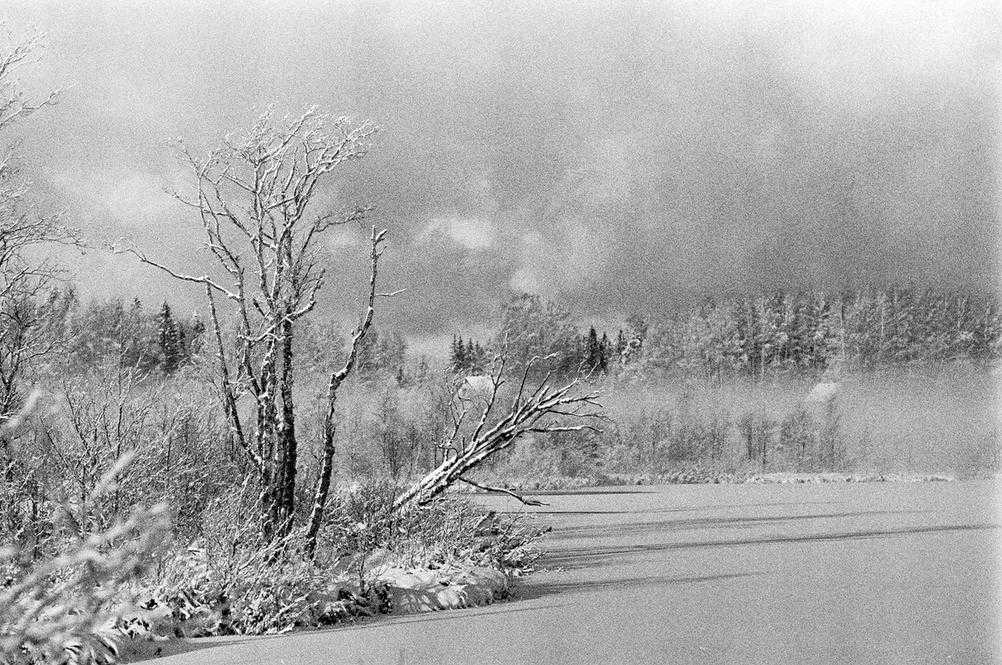
- Camera
- Canon Model 7
- Lens
- Canon LTM 135mm f3.5
- Film
- Ilford HP5+ EI200
- Development
- Compard R09 / Rodinal; Dilution 1:100; 1 hour semi-stand
- Scanner
- Reflecta ProScan 10T
Falling
Everything in the reproduction of this scene is to my liking. Contrast. Sharpness. Field of view. The overall feel.
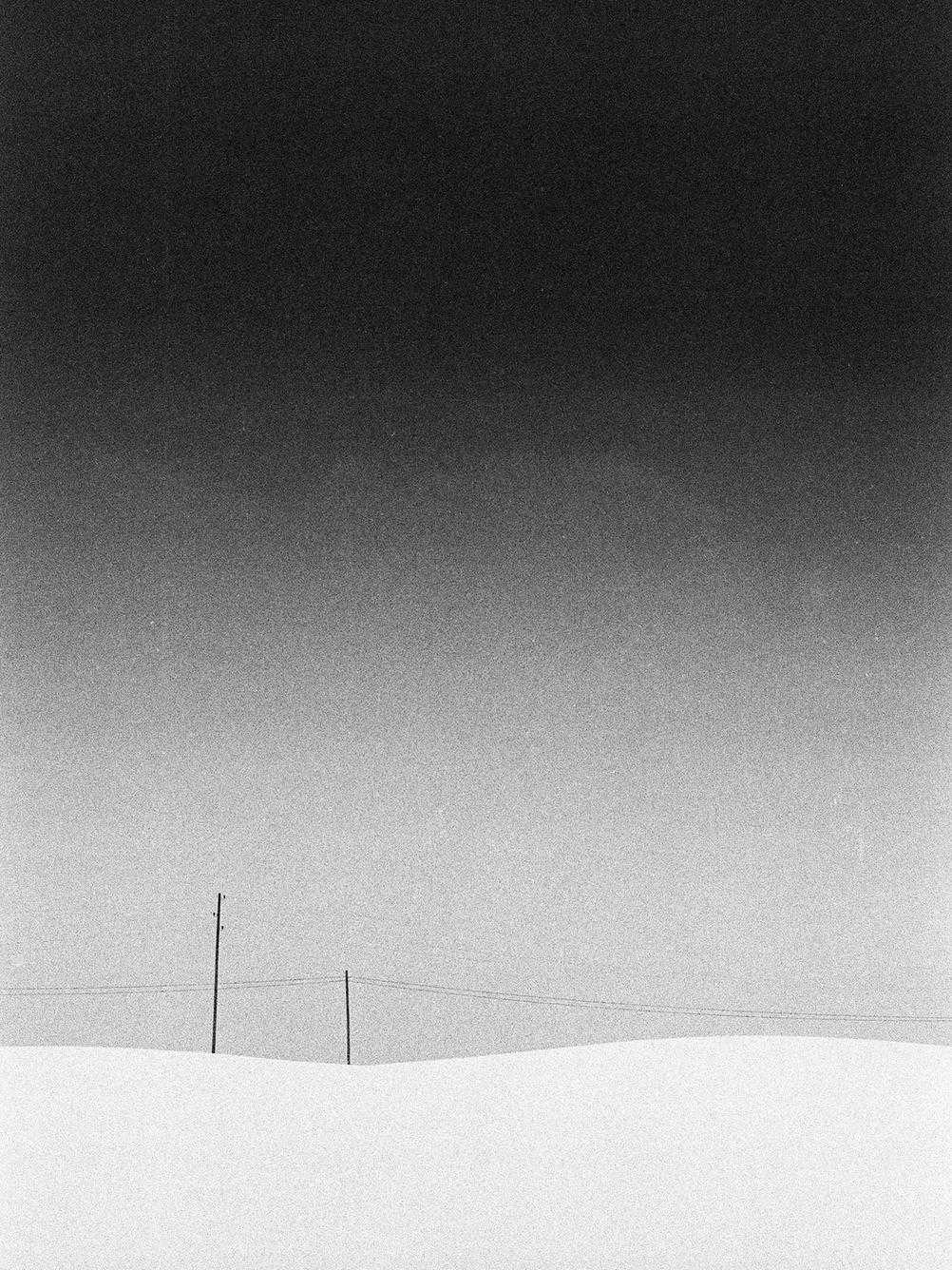
- Camera
- Canon Model 7
- Lens
- Canon LTM 135mm f3.5
- Film
- Kodak T-MAX 400 EI800
- Development
- Kodak HC-110; Dilution B; 7:00 min
- Scanner
- Reflecta ProScan 10T
Electric Two
135mm is great for picking out smaller details from a larger scene. This photo would not have the same impact when taken with a longer lens. And it would not have been practical to «just get closer».
If I was into portrait photography where there is no background then I could see using this lens more. But that is not something I enjoy shooting.
Should I sell this lens? No. It’s cheap ( as far as rangefinder lenses go ) and delivers great results from technical perspective. When I use it in winter I enjoy it a lot. And I enjoy the results. I am happy for it to be my winter lens.
Whilst it’s not the most exciting lens — it’s still worth considering buying one if you have a use for it. Long telephoto lenses are not easy to use on rangefinders. But it can be done. And it will be useful for when you need to single out an interesting patch of an otherwise boring scene.
Versions and history
There are two versions major of the Canon 135mm f/3.5. The older FD which was on the market from 1970 to 1978 version and the new FD version introduced in 1979.
Of the older FD model there are three different versions. The first version of these was introduced in 1970 and consists of 4 elements in 3 groups and 8 aperture blades. The second version was introduced in 1973 and has the same optical design but is slightly lighter. It still has 8 aperture blades. The third version that consists of 4 elements in 4 groups is significantly lighter and has only 6 aperture blades. This latest version was introduced in 1976. All three FD versions have the simpler S.C. coating
The newFD version introduced in 1979 is quite a bit lighter than its predecessors and it is a 4 elements in 4 groups design. It has 6 aperture blades and the more advanced S.S.C. coating. More information can be found here and .
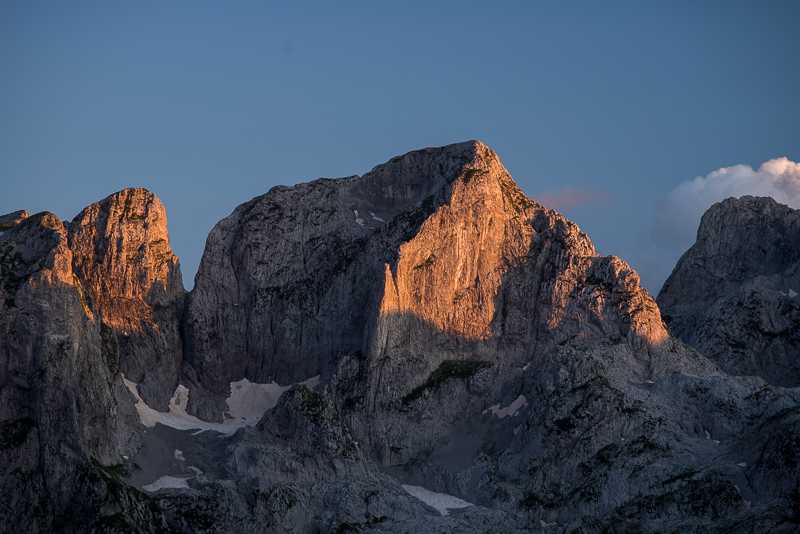 Sony a7II | Canon nFD 3.5/135 | f/5.6
Sony a7II | Canon nFD 3.5/135 | f/5.6
Reasons to Buy Canon RF 135mm F1.8 L IS USM Lens
Here we’ve included a summary of the advantages and disadvantages of the Canon RF 135mm F1.8 L IS USM lens in a list form to help you determine whether it offers the features you need.
PROs
| Optical Image Stabilization |
| Weather-sealed |
| Autofocus |
| AF/MF Switch on Lens |
| Aperture Ring |
| Focus Hold Button |
| Programmable Control Ring |
| Hood supplied |
| Full-time Manual Focusing |
| Fast Aperture |
| Covers Full-Frame Sensor |
| 9 Diaphragm Blades for Smooth Bokeh |
Report a correction
Buy Canon RF 135mm F1.8 L IS USM from or B&H PHOTO
CONs
| Pricey |
Lens Mount
Canon RF 135mm F1.8 L IS USM is compatible with cameras that have a Canon RF lens mount. Some of the latest released cameras that are compatible with the Canon RF lenses are Canon R100, Canon R8 and Canon R50.
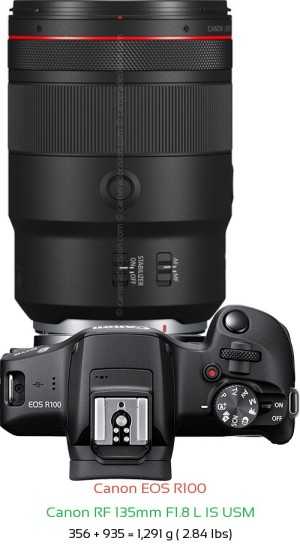 Canon R100 with the Canon RF 135mm F1.8 L IS USM Lens
Canon R100 with the Canon RF 135mm F1.8 L IS USM Lens
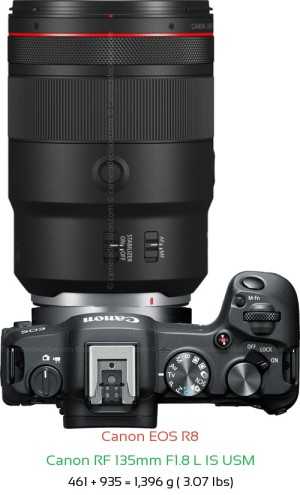 Canon R8 with the Canon RF 135mm F1.8 L IS USM Lens
Canon R8 with the Canon RF 135mm F1.8 L IS USM Lens
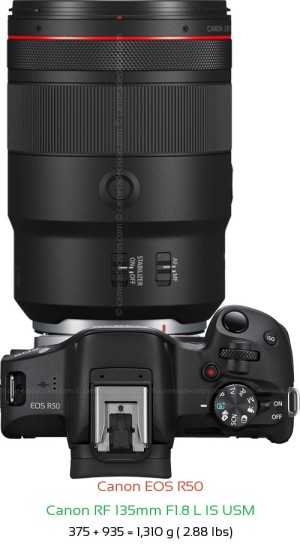 Canon R50 with the Canon RF 135mm F1.8 L IS USM Lens
Canon R50 with the Canon RF 135mm F1.8 L IS USM Lens
Size, Weight and Filter Thread
Size and weight is a very important decision factor when searching for your next lens. Canon RF 135mm F1.8 L IS USM has a maximum diameter of 89mm and total length of 130mm. It weighs 935g / 33.0 oz.
Below you can find a scaled side-by-side image of Canon RF 135mm F1.8 L IS USM and Sony FE 135mm F1.8 GM (Sony E mount) to get a better idea of how their sizes compare in real life. Check the detailed comparison of these two lenses here.
 Comparison image of the Canon RF 135mm F1.8 L IS USM and the Sony FE 135mm F1.8 GM Size and Weight
Comparison image of the Canon RF 135mm F1.8 L IS USM and the Sony FE 135mm F1.8 GM Size and Weight
Canon RF 135mm F1.8 L IS USM has a filter thread of 82mm. Below are links to the filters that we recommend you to consider for your Canon RF 135mm F1.8 L IS USM:
Optical Image Stabilization
The Canon RF 135mm F1.8 L IS USM features an optical image stabilization system which helps to reduce the blur that occurs due to shaking during hand-held shooting.
Focusing Mechanism of the Canon RF 135mm F1.8 L IS USM
Maximum Magnification Ratio
Canon RF 135mm F1.8 L IS USM has a Max Magnification Ratio of 0.26x and has a minimum focusing distance of 0.7m. For a non-macro lens, the 0.26x is considered a high magnification and will come handy for close-up shots.
Optical Formula
Canon RF 135mm F1.8 L IS USM’s optical formula consists of 17 elements in 12 groups . Special elements used in this design is 3 Ultra-low Dispersion.
Optical Construction of the Canon RF 135mm F1.8 L IS USM
Lens Hood
Canon RF 135mm F1.8 L IS USM comes with a removable lens hood which is handy to reduce lens flare and glare in your photos. The model number of the hood is Canon ET-88B.
Canon RF 135mm F1.8 L IS USM Lens Hood
Canon RF 135mm f/1.8 L IS USM Lens
Canon E-82 II 82mm Lens Cap
Canon Lens Dust Cap RF
Canon ET-88B Lens Hood
Canon Lens Case LP1319
Limited 1-Year Warranty
Popular Comparisons of Canon RF 135mm F1.8 L IS USM
Top Alternatives of Canon RF 135mm F1.8 L IS USM Lens
| Model | Coverage | Weight | Focusing | Street Price | |
|---|---|---|---|---|---|
|
Canon EF 135mm f2.0L USM Compare |
35mm FF | 750 g / 1.65 lb | AF | ||
|
Sony FE 135mm F1.8 GM Compare |
35mm FF | 950 g / 2.09 lb | AF | ||
|
Canon RF 100mm F2.8L Macro IS USM Compare |
35mm FF | 730 g / 1.61 lb | AF | ||
|
Canon RF 70-200mm F2.8L IS USM Compare |
35mm FF | 1,070 g / 2.35 lb | AF | ||
|
Sigma 135mm F1.8 DG HSM Art Compare |
35mm FF | 1,130 g / 2.49 lb | AF | ||
|
Canon RF 85mm F1.2L USM Compare |
35mm FF | 1,195 g / 2.63 lb | AF | ||
|
Canon RF 85mm F2 Macro IS STM Compare |
35mm FF | 500 g / 1.10 lb | AF | ||
|
Canon RF 50mm F1.2L USM Compare |
35mm FF | 950 g / 2.09 lb | AF |
Canon FD 35-70mm f3.5-4.5
The Canon FD 35-70mm f3.5-4.5 is the next up in this review.
It is a quite cheap lens, often back in the peak period for the Canon FD systems delivered as a kit lens for consumer cameras. I didn’t expect much from this, but I was surprised by decent results.
Shot at its widest focal length the 35mm and widest open aperture at 3.5 it is not very sharp and shows some vignette. This is clearly out of the usable area for a camera like the Hasselblad X1D with a super high resolution. At this aperture it just doesn’t make sense to put such glass (well actually it’s an all plastic construction – even the optics) in front of this camera. Well that is what I thought after inspecting the first shot, then I closed down the aperture and things started looking quite different.
From around f5.6 the lens is pretty sharp, and the image shown here from f11 is very usable. The visible vignette from f3.5 has diminished, the sharpness is acceptable throughout the image and is quite nice in the center area. Chromatic aberration is well controlled and contrast is just fine.
 Canon FD 35-70mm shot at 35mm f11. Vignetting is clearly visible but it is a soft vignette, that can be removed.
Canon FD 35-70mm shot at 35mm f11. Vignetting is clearly visible but it is a soft vignette, that can be removed.
Another nice characteristic of this lens is its color rendition which I like a lot. Of course this is a subjective view, but it feels in line with the superb color rendition of the Hasselblad camera and therefore is a good match. But it is really weird that this 10-30€ lens can produce something acceptable on a 6000€ camera. But lets have a look at how it performs at 70mm, where it might fall through.
Shot at 70mm this lens behaves a little strange both with respect to my expectations and compared with all the other lenses I have tested. The results show BETTER performance at f4.5 at 70mm than at f11. I’ll probably have to redo this in order to make sure I didn’t mess up something. What I observed was that there was a little vignetting and nice sharpness at 70mm f4.5, whereas I found a pronounced vignette at f11. Sharpness at f11 was nice though. A both apertures color fringing was at low levels and color rendition was very much to my liking.
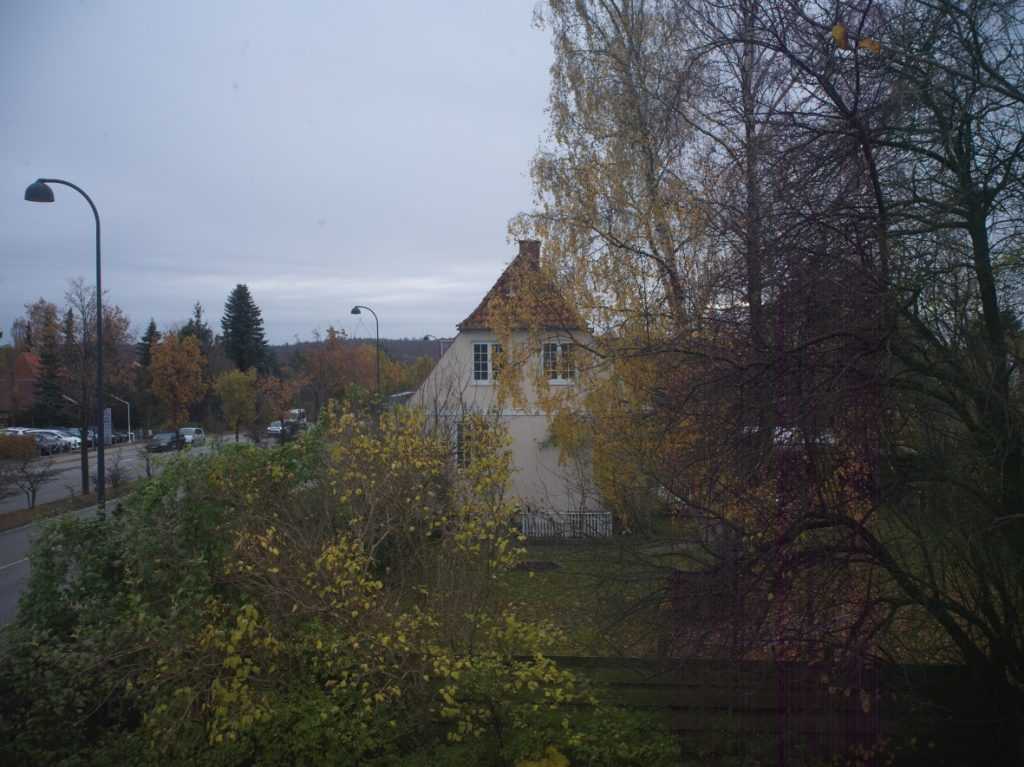 Canon FD 35-70mm f3.5-4.5 at 70mm f4.5
Canon FD 35-70mm f3.5-4.5 at 70mm f4.5
In conclusion the 35-70 3.5-4.5 is an unexpectedly good performer, if you use the sweet spots. Also it is very light and small lens, a good lens to carry around though I wouldn’t use it for really demanding shots where ultimate sharpness is required, and shot at 70mm f11 you would either have to crop the picture or correct the heavy vignette in post. But price/performance ratio can’t get much better
Visuals & Ergonomics
Old rangefinder telephoto lenses look funny to me. They resemble long tubes. And also feel like ones. In classic telephoto lens designs the majority of space is taken by air. The front element is where you expect — at the very front. The rear element is more towards the middle of the lens rather than the back of it.
The lens is light for a telephoto lens. It’s also thin. I’m sure it helps the weight but it looks funny on the camera. When off the camera the lens looks good. All black with some chrome parts. When attached to the camera it looks like a clown lens. A dark and brooding clown but a clown nonetheless. I don’t know why it looks like that to me but there we are. It’s not as funny as say Leitz Elmar 90mm f4 LTM but it follows similar principles.

A long tube attached to a camera. Not as bad as Leitz 90mm f4 LTM but it still gives off clown vibes.
Even if the lens doesn’t feel heavy — it is solid and dependable. Some lenses can grow a little play in the various moving parts that they have. Not this lens. Or at least my copy.
Lens has a clicked aperture. It goes from f3.5 to f22. Standard stuff. My copy has quite a dampened feel to the aperture ring. The clicks are definite and clicky but it doesn’t have that «crisp clickiness» feel that I like. All stops are spaced with equal gaps. Apart from f3.5 to f4 which is a smaller gap.
Focus ring is also dampened very well and doesn’t turn by accident. I would prefer a tad easier to turn focus ring. It could be down to the lubrication starting to cog up but I’m not so sure about that. It feels smooth and intentional but not to my preference. Focus throw is almost 360 degrees. The lens extends when focussing on close subjects and retracts when focussing on infinity. The distance travelled between closest and farthest focus is quite noticeable but doesn’t impact normal use. Closest focus distance is about a meter. There actually isn’t a distance mark on the closest focus point. Distance is shown in both meters and feet. It also has a hyperfocal distance guide but it’s not super useful for telephoto lenses.
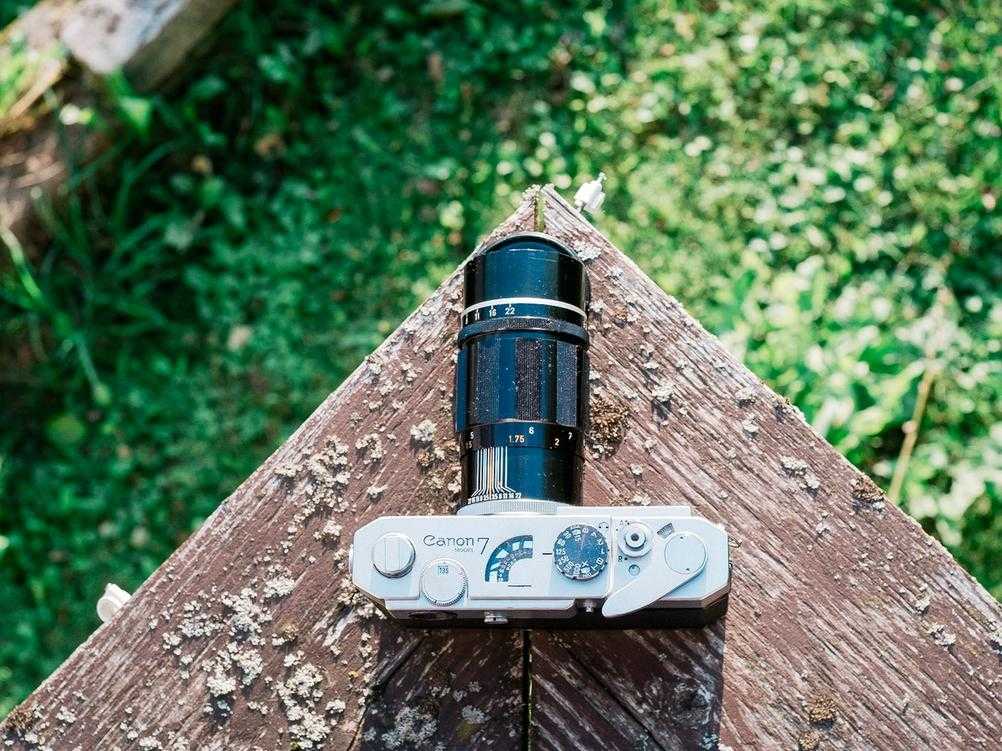
Hyperfocal distance guide is pretty useless — especially when focussing on something close by. It does have a nice look so still nice to have on the lens.
Технические характеристики
| Canon EF 135mm f/2L USM | Carl Zeiss Apo Sonnar 135/2 | |
|---|---|---|
| Фокусное расстояние | 135 мм | 135 мм |
| Тип фокусировки | автофокус, внутренняя | ручной фокус, наружная |
| Диапазон значений диафрагмы | f2-f32 | f/2 – f/22 |
| Оптическая схема (элементов/групп) | 10/8 | 11/8 |
| Оптическая стабилизация | нет | нет |
| Диапазон фокусировки | 0,91 м – ∞ | 0,8 м – ∞ |
| Рабочий диапазон | ? – ∞ | 0,62 м – ∞ |
| Углы обзора (диаг./гориз./верт.) | 18° / 15° / 10° | 18,7° / 15,6° / 10,5° |
| Лепестков диафрагмы, шт. | 8 | 9 |
| Диаметр круга покрытия | ? | 43 мм |
| Рабочий отрезок | 44,00 мм | 44,00 мм |
| Покрытие на МДФ | 124 х 185 мм | 145 x 96 мм |
| Масштаб на МДФ | 1:6.6 | 1:4 |
| Диаметр резьбы под фильтр | M72 x 1.0 | M77 x 1.0 |
| Положение входного зрачка (за плоскостью изображения) | ? | 34,5 мм |
| Угол вращения фокусировочного кольца (от ∞ до МДФ) | ~120° | 268° |
| Максимальный диаметр (с блендой) | 82,5 мм | 84 мм |
| Диаметр фокусировочного кольца | ? | 84 мм |
| Длина (без крышек) | ? | 108 мм |
| Длина (с крышками) | 112,0 мм | 130,0 мм |
| Вес | 750 гр. | 930 гр. |
| Анонсирован, г. | 1996 | 2012 |
Больше всего в этой таблице должна привлекать внимание последняя строчка — год анонса. Carl Zeiss Apo Sonnar 135/2 ZE выпущен через 16 лет после Canon EF 135mm f/2L USM
А сегодня уже 2017-ый год и в итоге прошёл уже 21 год с момента выпуска Canon EF 135/2L.
И тем не менее он всё еще в линейке объективов Canon. Из этого можно сделать вывод что:
1) 135 мм далеко не самое «любимое» Canon фокусное расстояние, раз они так редко делают обновление в этом фокусном.
2) Canon EF 135mm f/2L USM оказался достаточно удачным, чтобы просуществовать без замены так долго. Для своего времени это был объектив полный инноваций и супер резкий.
3) Canon EF 135mm f/2L USM устарел и ему неплохо бы выпустить замену. За это время появились камеры высокого разрешения, о которых в далёком 1996-ом и мечтать нельзя было.
Сравнение Canon EF 135mm f/2L USM с Carl Zeiss Apo Sonnar 135/2 ZE
По графикам MTF

По графикам MTF представленным компаниями Canon и Carl Zeiss выходит, что Canon EF 135mm f/2L USM уступает объективу Carl Zeiss Apo Sonnar 135/2 ZE, но не совсем «разгромно», как можно было бы ожидать. Здесь можно только предполагать где пройдет кривая разрешения (40 lp/mm) у Canon. К сожалению, уже и 40 lp/mm недостаточно точно описывает характеристики современных объективов, учитывая их использование на камерах с разрешением в 42 или 50 Мпикс.
По фотомирам
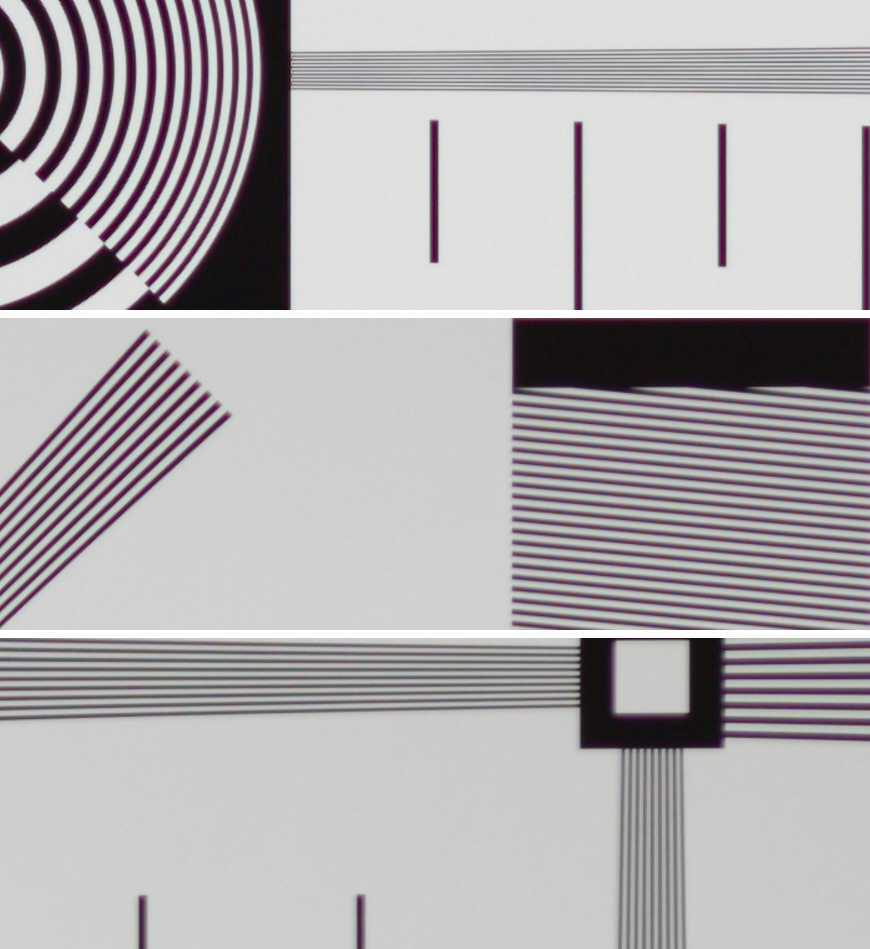
По фотомире разница в разрешении очевиднее. Canon EF 135mm f/2L USM «страдает» от существенных ХА, которые странно было бы не наблюдать у объектива 90-ых годов прошлого века. В целом мы можем наблюдать здесь относительно высокое разрешение приправленное высокими ХА. А что в итоге, как это повлияет на картинку?
Все снимки сделаны на значении диафрагмы F2.
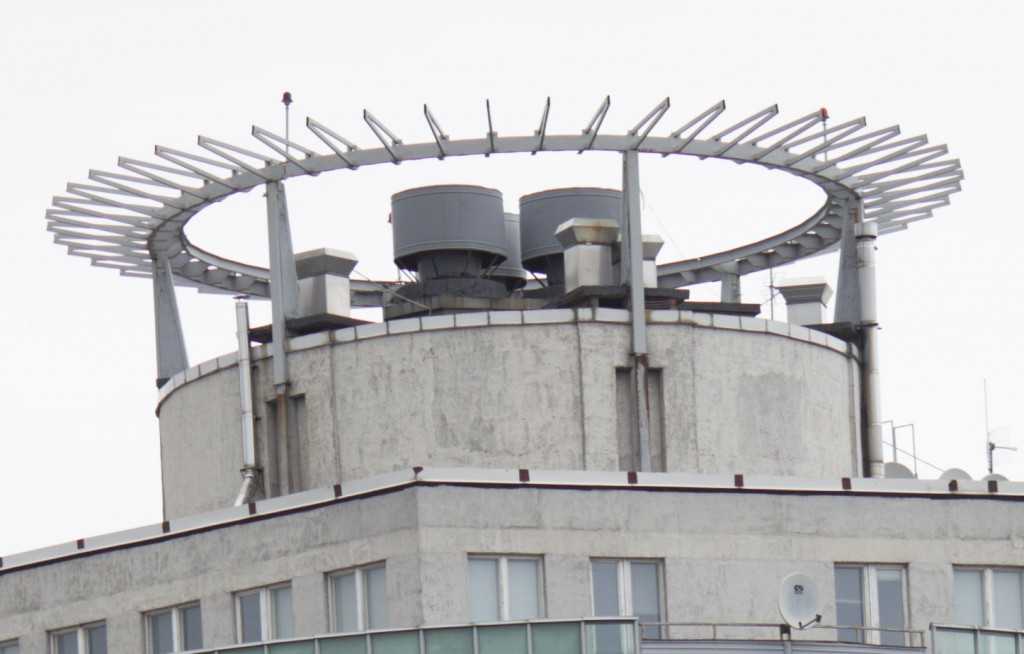
Если смотреть по центру кадра и рядом с ним, то всё довольно неплохо. ХА хоть и очевидны, но картинку портят не сильно.
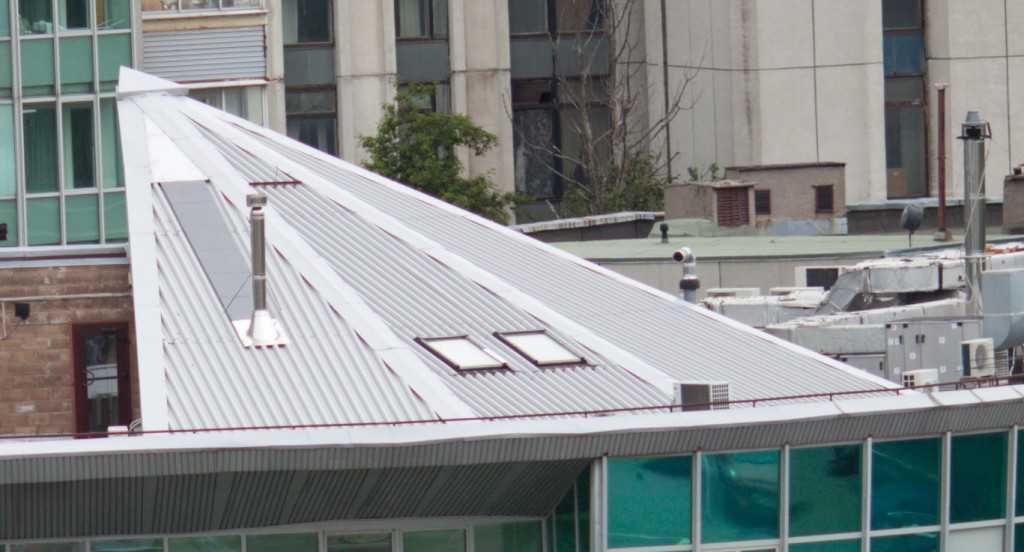
центр кадра
Хуже ситуация в зоне размытия.
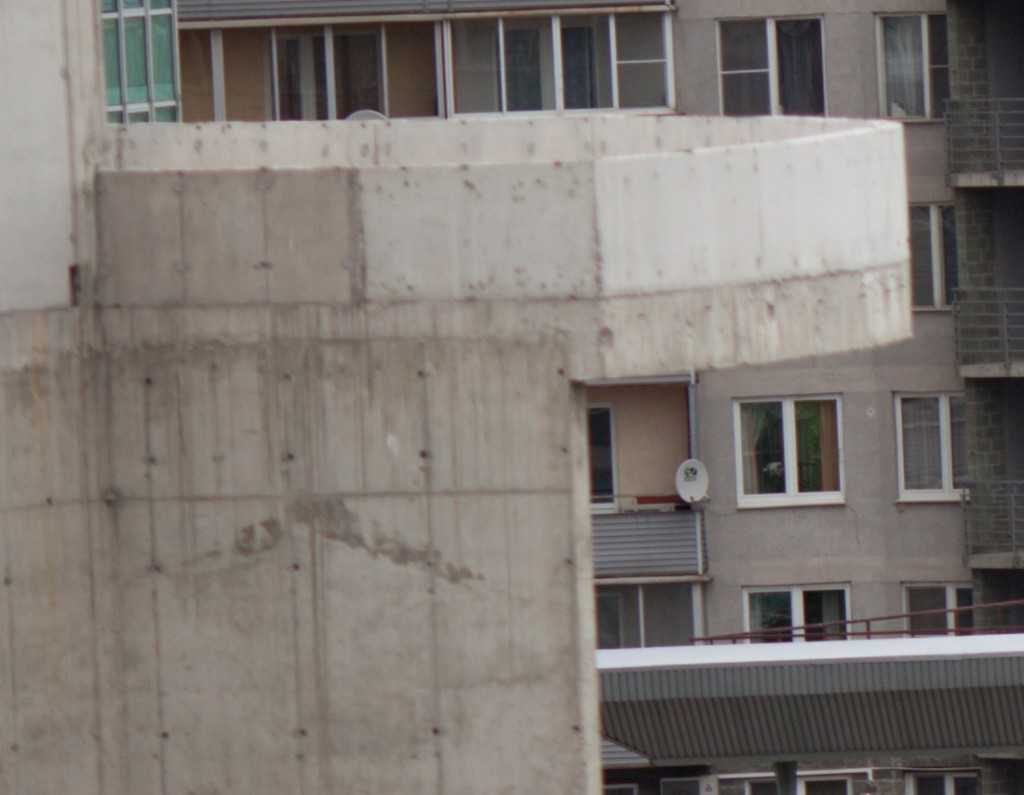
Аберрации складываются и образую некую кашу с фиолетовым налётом вместо просто размытого изображения.
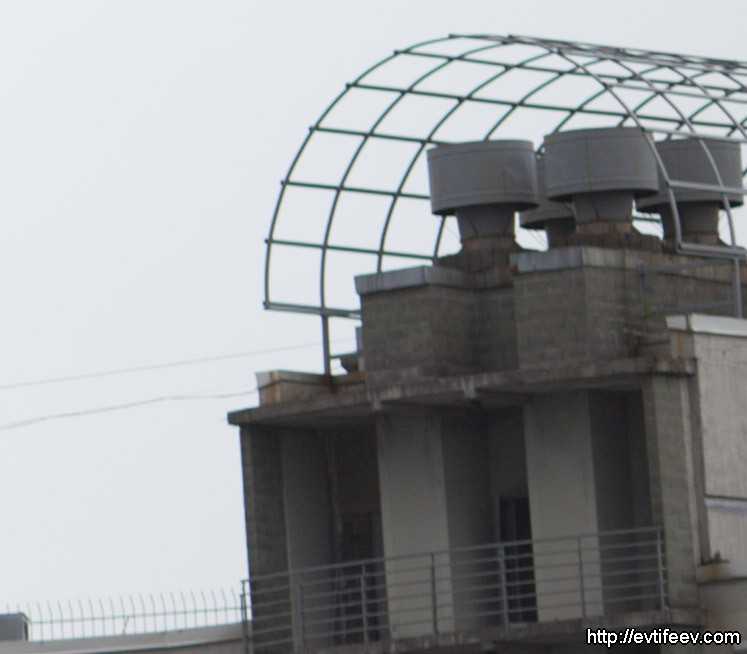
край кадра
По краю кадра ХА усиливаются.
Тест телеобъективов на 135мм
Объектив(ы):Canon EF 80-200 mm f/ 4.5-5.6 II(посмотреть технические характеристики)Tokina SD 70-210 mm f/ 4-5.6(посмотреть технические характеристики)Tokina AT-X 60-120 mm f/ 2.8(посмотреть технические характеристики)Carl Zeiss Jena 35-135 mm f/ 3.5-4.5 MC Macro Jenazoom(посмотреть технические характеристики)Strathconar 135 mm f/ 2.8 Auto(посмотреть технические характеристики)
Один человек попросил меня протестировать объектив Carl Zeiss Jena 35-135 mm f/ 3.5-4.5 MC Macro и сравнить его с другими моими объективами 135мм. Вот что из этого вышло.
Условия теста:
1 Место: Россия, Сибирь, тюменская область, город Ишим.
2 Время: 22 сентября 2015 года, около 11 часов по местному времени
3 Погода: прохладная, переменная облачность, солнце за небольшой пеленой.
4 Камера Canon 5D MarkII, все объективы из набора в исправном состоянии без грибка и царапин, кроме злополучного цейса.
5 Направление камеры на юг, против солнца, камера установлена на штатив, автоспуск 2 секунды.
6 Все снимки сняты в CR2 формате, в приоритете диафрагмы, при обработке корректировалась только яркость.
Результаты тестов в JPG можно посмотреть тут:https://cloud.mail.ru/public/F4FQ/9cbjpeWWq
Результаты тестов в увеличении, центр кадра:Предварительные выводы:
Не все цейсы одинаково хороши или «Цейс не Цейс когда ты голоден»
Конкретный экземпляр из обзора Carl Zeiss Jena 35-135 mm f/ 3.5-4.5 MC Macro на поверку оказался с браком.
Купил на ебэй не дорого. Продавец писал мол хороший объектив, всё вери гуд. На самом деле линзы после ремонта, хотя внешне всё выглядит замечательно, кроме стертой краски со шлицов передней линзы. Объектив неисправен — отсюда и такой результат.
На открытой диафрагме 3.5
Фокусировка на 2 метра
Tokina AT-X 60-120 mm f/ 2.8
Токина порадовала ровным бокэ, хорошей резкостью и сильным размытием заднего плана. В общем это и не удивительно, этот объектив в 80-е годы был флагманом японской фирмы. Он и сейчас, спустя тридцать лет весьма интересен. Можно использовать и как портретник и как объектив для репортажных съемок. Качествееная конструкция и качественное стекло. Хочу отметить одну особенность объектива — баланс белого он уводит в сине-зеленые тона. В остальном это хороший зум-объектив, который впрочем всё равно уступает в резкости фикс-объективам тех же годов выпуска.
На открытой диафрагме 2.8, фокусировка на 2 метра:
Tokina SD 70-210 mm f/ 4-5.6
Самый резкий объектив в тесте. Темный, но резкий. Самый недорогой, но самый резкий экземпляр. Такое бывает.
Для портретов непригоден, но для макро это очень хороший объектив.
На открытой диафрагме 4, фокусировка на 2 метра:
Canon EF 80-200 mm f/ 4.5-5.6
Кэнон это кэнон. Ждать чудес от бюджетного темного автофокусного объектива бессмысленно. Объектив сделан в начале 90-х годов, и поэтому имеет лучшие характеристики оптики чем у остальных объективов в обзоре. У него исправлены ХА и другие недостатки. Он всем хорош, за исключением светосилы…. и несмотря на низкую светосилу на 135мм он прекрасно размывает задний план. Удивительно, но я пока не нашел этому объяснения. По резкости мой экземпляр в этом обзоре — один из лучших — он делит пальму первенства с фиксом Strathconar 135 2.8 Но в плане бокэ этот объектив не интересен. Бокэ как кисель, размытое непонятно в каую форму….Для съемки природы и портретов я бы его не рекомендовал, а вот для репортажа — в самый раз.
На открытой диафрагме 4.5 и фокусировка на 2 метра
Strathconar 135 mm f/ 2.8
Strathconar 135 mm f/ 2.8 — темная лошадка в этом обзоре. Я его купил случайно на ебэй вместе со старой сломанной Практикой. Можно сказать, что он достался мне даром. И долгое время я относился к нему как пасынку. Ну то есть что даром досталось — то как бы и не ценится.
Я сильно ошибался насчет этого объектива. Он очень резок, и удобен в обращении. Конечно, это фикс, а значит фотографу придется всё время перемещаться в пространстве в процессе построения композиции и кадрирования. Но взамен он получит лучшее качество картинки которое возможно для мануальных объективов 70-80хх годов.
Отличный портретник для своего возраста и своих характеристик.
На открытой диафрагме 2.8, фокусировка на 2 метра:
Вместо Эпилога….
Я сначала подумал что где-то ошибка.
Не может цейс быть настолько плох….
И я сделал ещё один тест…
Carl Zeiss Jena 35-135 mm f/ 3.5-4.5 MC Macro против Strathconar 135 mm f/ 2.8
Зум против фикса.
Бренд против безымянности.
Но всё оказалось просто: цейс после ремонта, на передней части следы вскрытия, которые я сразу не заметил.
Крупнее в центре:
Исходники CR2 можно посмотреть тут:https://cloud.mail.ru/public/6sq2/x661Cbuaf


